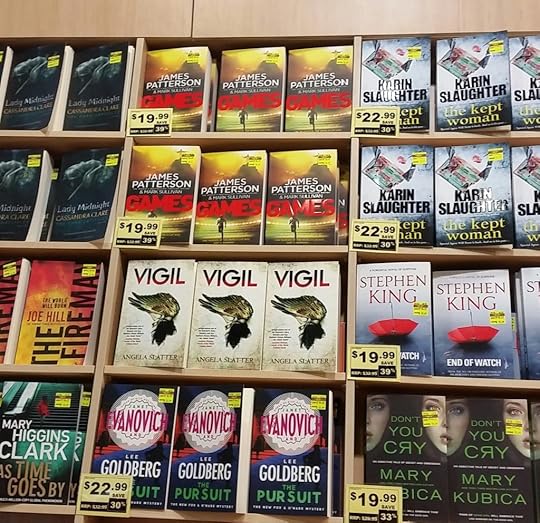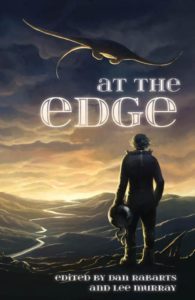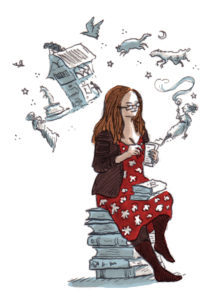Angela Slatter's Blog, page 56
July 12, 2016
Vigil in the Wild
 Thank you, Nicky Strickland for sending me this. This is the culmination of twelve years of effort. Admittedly, I/Vigil feel like Alex the Lion from Madagascar tying to fit in with the locals on the veldt, but I’ll try not to eat with my feet and generally make peeps think (know) I’m a ring-in!
Thank you, Nicky Strickland for sending me this. This is the culmination of twelve years of effort. Admittedly, I/Vigil feel like Alex the Lion from Madagascar tying to fit in with the locals on the veldt, but I’ll try not to eat with my feet and generally make peeps think (know) I’m a ring-in!
One Life, No Respawns: Tom Dullemond

Tom and Marcus
Tom Dullemond stumbled out of university with a double degree in Medieval/Renaissance studies and Software Engineering. One of these degrees got him a job and he has been writing and working in IT ever since. Tom writes primarily short fiction across all genres, including literary fiction and the occasional poem. He co-authored The Machine Who Was Also a Boy, the first in a series of philosophical fantasy adventures for middle-grade students, and has short fiction published in a handful of anthologies and magazines including Suspended in Dusk, Danse Macabre and Betwixt Magazine. He is the co-creator of Literarium, an online writing management portal.
1.What inspired your At the Edge story?
I was walking across a railway bridge with my young autistic son, and he was getting quite excited by the train, so I told him never to run in front of a train because that would be dangerous. He replied, ‘That’s ok dad, I’ll just respawn,” with all the certainy of a modern gamer. My reply was a firm, “No, you’ll be dead and I’ll be sad. You don’t respawn: one life, no respawns.” And that title spoke to me and worked its way into that notion of futuristic military, gamification, and then naturally to the question of how we neglect the particular needs of ex-military people.
2. What appealed to you about this project?
The chance to work with Lee and Dan OBVS. But also the breadth of the theme.
3. What do you love about short stories?
I love that they have to be efficient, that they demand focus and refinement in a way that is very different from the demands of a longer, more leisurely piece of work. I like that I can write about different ideas and plots and people and experiences without having to dedicate months or years of my life to a single project
4. Can you remember the first thing you ever read that made you want to write?
Europe has a rich comic book culture that is completely different to the US-centric super hero style comic scene. Reading European comic magazines as a child inspired me, particularly visual fantasy series like ‘Douwe Dabbert’ (which no one outside of the Netherlands/Belgium/France will ever have heard of). The narrative elements of early Disney feature-length cartoons have stuck with me too. I try to capture a lot of those visceral, visual elements of animation in my short fiction.
5. What’s next for you? 
Final edits on book 2 of my middle-grade philosophical fantasy series Pandora’s Paradoxes, more short fiction, and finally launching www.literarium.net!
July 11, 2016
Signed copies of Vigil in Brisneyland

Photo by Hachette peeps
So today is the Official Vigil in stores day! As you can see by the celebrating Hachetteers to the left.
I went in to visit with the lovely Pulpsters and what should arrive as I stood at the counter chatting and generally interrupting (okay, entirely stopping) productivity? This!

Ron of Pulp Fiction Booksellers fame
And so, I signed a few – but you should still come along to the launch on Tuesday 19 July and have a cupcake!

July 10, 2016
New Short Fiction – Dark Discoveries
 I’ve got a new short story in the latest Dark Discoveries.
I’ve got a new short story in the latest Dark Discoveries.
It’s the one with Mr Joe Hill on the cover, and has the theme of War and Apocalypse. You’ll also find:
All new Fiction by: Ann Christy, Nick Mamatas, Kane Gilmour, A. Scott Glancy, Angela Slatter and Gary Raisor.
Interviews with: Joe Hill, A. Scott Glancy, Jeremy Robison, Kane Gilmour and more.
Articles on: Words from the Wise: John Shirley, Nick Antosca, and Geoff Brown by Chris Kelso and Writing Conflict: A Lament with Lisa L. Hannett by Aaron J French.
Columns from Mike Davis, Laird Barron, Robert Morrish, Donald Tyson and Richard Dansky!
Dark Poetry: Bryan Thao Worra.
July 9, 2016
Despatches from KSP – Day 14: How to Commit Critique

Art by Kathleen Jennings
Despatches from KSP – Day 14: How to Commit Critique
Well, this will be my last Despatch from KSP! Tomorrow I head home to Brisneyland and my normal life. I’m looking forward to catching up with family and friends, sleeping in my own bed, cuddles with the Tech Badger, and snuggling up to my newly arrived Vigil banner (don’t judge me!).
I’ve had a fantastic time at KSP – the quiet and the lack of distractions here at Katharine’s Place have been fantastic. I have achieved so much more than I would have at home where all my obligations and books live (not that I don’t love them, but the break has been nice). I thought for my last despatch I would give my Top Ten Tips for Committing a Critique.
So, if you’re part of a writers group (and you probably should be, at least in the early part of your writing journey), you’re going to have to critique other people’s creative endeavours. The first principle you need to keep in mind is respect for the work you’re considering. It might not be in your preferred genre, it might not be the story you’d have written, but you owe it to the person who wrote it to give it your best attention. This doesn’t mean you have to be nice, i.e. avoid saying anything critical, but it does mean you don’t denigrate either the writing or its author.
It’s never acceptable to give a critique that is simply “I JUST DIDN’T LIKE IT” because that’s not helpful. Why didn’t you like it? What didn’t work for you? You say “This characterisation didn’t work for me because I found John unconvincing/his motivation unlikely; perhaps you might consider how the character might work with/as a different gender/age group/racial group/attitude to life/motivation/etc.” Direct the comments to the work, not the writer – this is not personal.

More Kathleen art
You need to think carefully about the story you’ve read and the points below will hopefully help you to focus your critique in a manner than is meaningful and useful for the author – and they should also help you when you’re writing and editing your own work, because critiquing isn’t simply an exercise for others to learn from.
If you expect other people in the group to critique your work, then you must critique theirs in return. Few things are worse in a writers group than that one person who takes and never gives. Don’t be that person.
When you read the work, acknowledge your genre biases and assess the work without falling back on them. Assess the story based on its strengths and weaknesses, don’t judge it because you personally don’t like science fiction or crime or romance fiction, etc. The point of the exercise is to improve the story and make it the best it can be.
Are the characters convincing? Are they well-rounded or stereotypical? Are motivations and relationships clear? Do we know enough about a character’s past and present to understand the story action? Or too we get too much information about a character, info that is not at all relevant to our understanding of the story? Are there too many characters? Can a couple of them be spliced together to cut down the cast?
Does the setting work? Does the secondary world remain intact all the way through? Can you as a reader envisage where the story is taking place, not just the house or room it’s in, but the greater world of the town/city/state/country/world? Are there obvious location talismans that show a reader where they are? For instance, the Eiffel Tower is emblematic of a Paris setting, Big Ben of a London setting. Houses with red tiled roofs and steep cobbled streets suggest a Mediterranean setting, a snowy tundra suggests a northern one. Are these talismans there for a reader and are they effectively deployed?
Are the descriptions effective or are they over-written – or even under-written? If it’s a short story, then are the descriptions pithy, using just the right number of words? Or are they overdone, heavy, filled with irrelevant details that don’t contribute to the reader’s enjoyment and understanding of the story? If it’s a longer work, is there enough detail or does it feel a little sparse, under-developed? Or is there a evidence of an info-dump: All Of The Information given at one time in a very long paragraph, instead of scattered throughout the rest of the narrative? Are there a lot of lazy repetitions of word, act and deed?
Do the voice and point of view remain consistent and believable throughout? Or does it feel as though your narrator has changed mid-way through the tale?
Does the plot proceed logically from beginning to ending so the story makes sense? Does the tale reach a conclusion that’s logical within the story world? Does the story’s structure support this? Has the writer missed out an important step, e.g. if the house blows up at the end of the story, someone must have purchased dynamite earlier on, and someone must light the fuse. Are all the causal link boxes ticked?
Does the writer give the reader everything they need to understand the story or do they digress to possibly interesting but irrelevant information? Can that info (if it’s interesting) be cut back and integrated into the story to make it relevant? Or should it simply be deleted?
Does the dialogue move the story along, speak to character and give the reader the information s/he needs? Does it tell the reader about the characters’ hearts? Does it subtly foreshadow things to come? Does it help set the mood of the tale? Is a character’s dialogue consistent with their background; i.e. do the post-apocalyptic warriors sound like they belong in Downton Abbey? Is there a good reason for this or is it a misstep?
Is there a discernible theme to the tale? If it’s a short story, then is there evidence of Poe’s “single effect” so that it’s not overrun with too many ideas that don’t work together but rather draw the attention in a hundred different directions? Do all elements of the story contribute to this theme?

More!
This isn’t an exhaustive list, but it is a good place to start! As you proceed on your writing journey, you’ll add other things to the list and become more able to recognise problems in your own and other people’s work, and to offer useful suggestions for remedying said problems. Good luck!
July 8, 2016
Stefen’s Books!
 Has signed copies of Vigil!
Has signed copies of Vigil!
And some unsigned ones for those who prefer the unsullied.
So get ’em while they’re hot, Perthites!
July 7, 2016
Vigil: The Release Day That Was
 Vigil was released into the wild yesterday! Yay! Less yay was the writer being sick all damned day and unable to celebrate. Wah!
Vigil was released into the wild yesterday! Yay! Less yay was the writer being sick all damned day and unable to celebrate. Wah!
But my beautiful baby is out there.
To all who bought a copy, and to those who have left reviews (on their websites, Goodreads and Amazon – like Jim from Gingernuts of Horror – be like Jim) and to those who will do do so, I offer many thanks and virtual hugs.
July 6, 2016
Top Ten Pets for Writers: the Good, the Bad, the Really, Really Unwise
 Over at the JFB blog I offer advice about pets for writers. I should point out I don’t own any pets. But Sam from JFB did add excellent gifs.
Over at the JFB blog I offer advice about pets for writers. I should point out I don’t own any pets. But Sam from JFB did add excellent gifs.
Writers are often solitary creatures, and this isn’t always a good thing. You start talking to yourself and people look at you strangely, especially when you start to do it outside of the home environment; in the supermarket for example. So, I propose all writers should have a pet of some description – that way, at least you’re talking to something instead of an imaginary friend – even if its a stuffed animal because you can’t be trusted to remember to feed a living creature (plants are probably also not for you).
Each pet gets an ego rating – as in how well they’ll affect your ego – on a scale of 1 to 10, with 1 being ‘This pet will make you hate yourself’ and 10 being ‘This pet believes you are a god’.
The rest is here.
Despatches from KSP – Day 11

Art by Kathleen Jennings
Despatches from KSP – Day 11: Top Five Tips for Public Readings
Last night I had the pleasure of attending the KSP Literary Dinner and talking to people who are passionate about writing and reading. We were fed lovely food and I had the opportunity to read “The Badger Bride” (which was shortlisted for the Aurealis Award for Best Fantasy Short Story for 2014- but was beaten by “St Dymphna’s School for Poison Girls” by some hack) aloud. I was scheduled to do three readings between courses, about 10-15 minutes each. That’s usually a long time for a reading – most events only want about 3-5 minutes, and that’s what I’ve trained myself to do, but I was up for the challenge. The story had natural breaking places and was well received – huzzah! – so I thought I’d give my Top Five Tips for Public Readings.
1. Choose an event-appropriate piece
You need to consider your audience and venue when you’re selecting something to read. It’s an unwise choice to debut the profanity-laced decapitation scene from your new spy thriller at a children’s books festival – just saying. Who will be listening to you? Are they likely to be genre readers or more on the side of Big L Literature? Are you going to be reading at a festival, in a bookstore, in a bar (dingy or otherwise)? Choose your piece to suit the audience, the occasion and the vibe of the venue. Also keep in mind whether you’re going to have a microphone or will need to use your best projecting voice.
If you can, read a short story that fits into your time limit – this gives the audience a nice sense of completion. If you’re reading an extract from a novel-length work (maybe your new book is coming out and promotion is foremost in your mind) then choose carefully: you don’t want it to be too slow, you don’t want it to give too much away (don’t read the end!), and you don’t want to have to spend too much time on an introduction to the piece that is longer than the piece itself so the audience will understand the context.
If you’re a second-stringer – an up-and-comer at, say, a salon evening which has a big name as the drawcard – then choose something snappy and complete. You’re not there to compete with the star, you’re there to be an able support act until you hit the big time. Give a good performance that people will remember for the right reasons.
2. How long is a piece of string?
As I said above, usually I’ve been asked to read 3-5 minute pieces, and that’s what I normally prepare. It’s a good length of time: less chance of an audience getting restless, less chance of you running out of breath, and a goodly span to tell a tale, whether it be a whole short story or an extract from a longer work. Make sure you always check with the organiser as to their expectations. If you know you need to do a longer reading – some writers festival spots are thirty minutes long – then you must prepare.
3. Practice makes perfect
You need to read your chosen piece aloud. You need to read it more than once. You need to read it before you have to perform it. The reasons for this are several-fold.
Firstly, so you get to know its rhythms, so your tongue isn’t getting tripped up as if it’s meeting the words for the first time – there are few things more uncomfortable for an audience than listening to an unprepared reader, and few things more terrible for a reader than hearing the shuffles and coughs and whispers of a bored audience. Or worse still, the sound of a chair being pushed back, of someone making excuses as they exit from the middle of a row of seats, tripping over audience members too polite to leave.
Secondly, what looks perfectly lovely on the page does not necessarily sound perfectly lovely when spoken aloud. Sentences might not have the same rhythm on the tongue and to the ear; when you’re practising, keep a pencil handy and cross out any lines that strike you as superfluous or overly long or complicated, likely to cause tangle-tongue. Don’t cross out important details the audience needs in order to understand the tale, but perhaps reword things for easier articulation. Know where the pauses need to be, know the cadences of your sentence so the words sing from your tongue, rather than sounding like a parent at three a.m. stumbling over a floor covered with Lego.
Thirdly, listening to yourself read will help you get the voice right, the tone you want to deliver the story in – the pitch that will do it justice. That will make the listening experience for the audience all the richer – and keep the number of shuffles, coughs and whispers to a minimum. You will also hear whether you’re one of Life’s mumblers – if you are, remedy that immediately. Don’t chew on your words, don’t let the nerves get hold of you and make you vomit them out at speed. Take a deep breath before you start; it’s calming, it helps you feel in control. Not to mention that doing a few run-throughs will help you control your breathing whilst reading, and the words will stop feeling so terrifying when you’ve got used to them.
Fourthly, you need to get your timing right. You might be utterly certain that those thirty pages equal five minutes. They don’t. Trust me, they really don’t. It’s agonising to hear a reader panic and speed up, or stop mid-sentence and leave the stage apologising because they realise they’ve been going on for twenty minutes in a three minute slot.
4. Always give your all
No matter how many or how few people turn up to your reading, always give the same performance. You may well feel disappointed that only two blokes and one chicken wearing an eye-patch have turned up to hear you – that’s only natural – but the important thing is not to act that way. Give the same level of performance as you would to an arena of cool kids and celebrities. Why? Because the folk who’ve bothered to turn up will go away and tell others about you and your work – what you want them to say is “It was a great reading! Look out for this author!!!”not “Total douche-canoe, bro, don’t ever bother reading their stuff.”

Yes, it’s a Kathleen Jennings cup from Bitterwood
5. Save the best for last
Finally, I know it’s nerve-wracking to stand up and speak in public, and it feels so much worse when you’re doing something creative, but consider not drinking beforehand to settle the nerves. Sure, alcohol loosens inhibitions, makes us relax … but sometimes it loosens inhibitions so much we think, “Yeah, three drinks of the cheap and nasty wine will be fine, I feel great, I’m confident!” But by then you’re slurring; the words move around on the page; maybe you trip up the stairs to the dais/podium; you’re talking too loudly, too quickly, you’re not funny. I have been in audiences where the author is sloshed – I have paid to be there – and I’ve not been happy or impressed. This isn’t based on any Temperance League objections to booze, just a preference for professional behaviour. “There’s many a slip ‘twixt the cup and the lip” as the saying goes – don’t get caught out saying something you probably shouldn’t because you’re too relaxed. Or worse: unintentionally ending up as the newest YouTube sensation.
Save the drink for afterwards, for the celebration, when no one cares if you’re a bit messy, in fact they think you’ve earned it.
July 5, 2016
Much Vigil-related Excitement
 Master Maxim Jakubowski has selected Vigil as one of his July picks over at LoveReading!
Master Maxim Jakubowski has selected Vigil as one of his July picks over at LoveReading!
Striking urban fantasy set in Brisbane, featuring the indomitable but ever grumpy Verity Fassbinder, of mixed human and magical ‘weyrd’ stock and with special powers to walk between worlds. She, however, only uses her powers with discretion, preferring to blend into normalcy rather than stand out and monitor the balance between worlds. But when children and sirens start going missing, the call to action cannot be resisted in a city in which reality seems to be leaking and a terrible menace is looming. Verity has touches of Katniss Everdeen but quickly establishes herself as a strong, likeable and positive female heroine in her own right, and her topsy turvy adventures fighting for the powers of good in an almost divergent world are pleasing and fast-paced. This is the opening to a trilogy and the next volumes will prove most welcome. ~ Maxim Jakubowski



